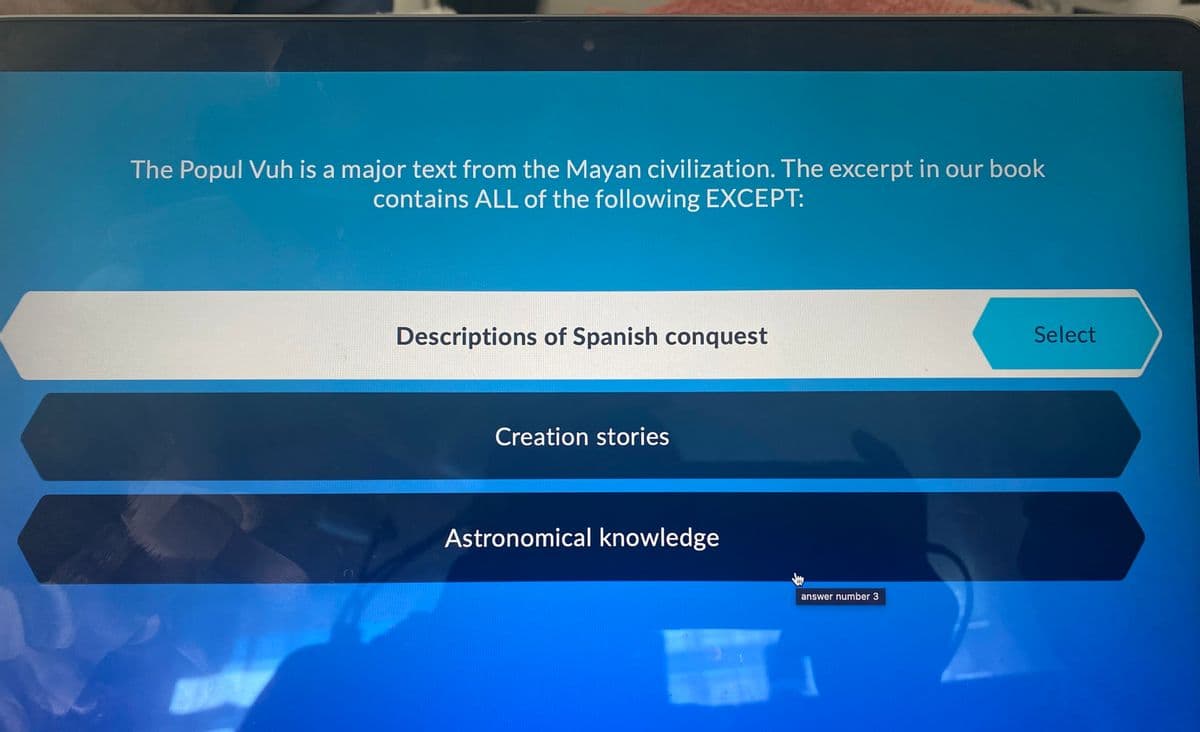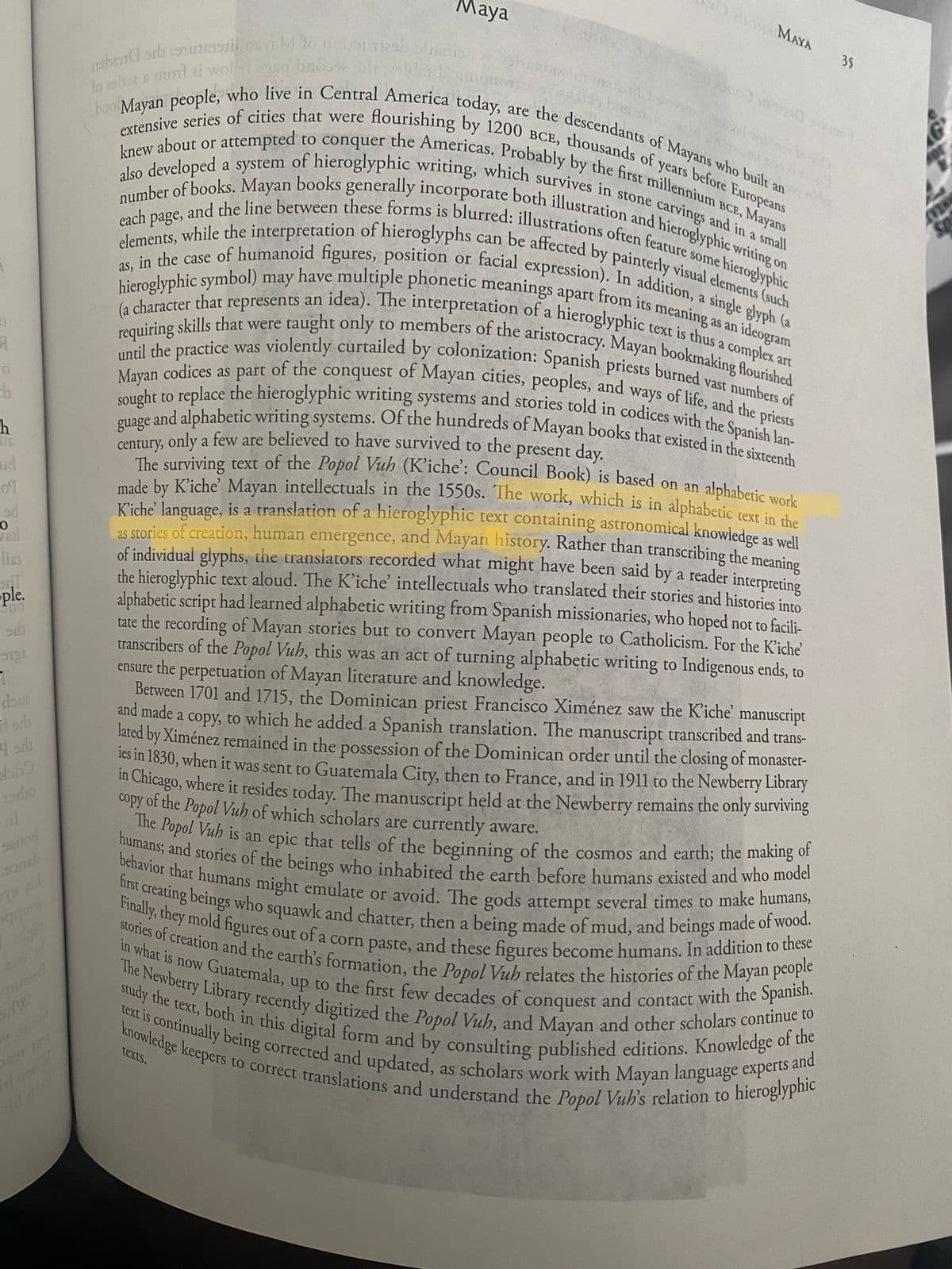The Popul Vuh is a major text from the Mayan civilization. The excerpt in our book contains ALL of the following EXCEPT: Descriptions of Spanish conquest Creation stories Astronomical knowledge answer number 3 Select
The Popul Vuh is a major text from the Mayan civilization. The excerpt in our book contains ALL of the following EXCEPT: Descriptions of Spanish conquest Creation stories Astronomical knowledge answer number 3 Select
Related questions
Question
I think the answer is Descriptions of Spanish conquest and I have highlighted where I found it in the book and wanted to make sure if its the correct answer.

Transcribed Image Text:The Popul Vuh is a major text from the Mayan civilization. The excerpt in our book
contains ALL of the following EXCEPT:
Descriptions of Spanish conquest
Creation stories
Astronomical knowledge
answer number 3
Select

Transcribed Image Text:59.
ED
tb
h
ils
ud
201
ed
O
VBI
lis
ple.
១៧
STRE
1
dour
9 sdi
bho
19/10
nl
savod
.sonsh
ya aid
aggarw
2209
dw
Maya
texts.
nsbasada estil de to notorrab sinis
sa brosse sch
lo 29h e moil ei wol
bop Mayan people, who live in Central America today, are the descendants of Mayans who built an
flourishing by 1200 BCE, thousands of years before Europeans
extensive series of cities that were
knew about or attempted to conquer the Americas. Probably by the first millennium BCE, Mayans
also developed a system of hieroglyphic writing, which survives in stone carvings and in a small
number of books. Mayan books generally incorporate both illustration and hieroglyphic writing on
each page, and the line between these forms is blurred: illustrations often feature some hieroglyphic
s can be affected by painterly visual elements (such
elements, while the interpretation of hieroglyphs
as, in the case of humanoid figures, position or facial expression). In addition, a single glyph (a
(a character that represents an idea). The interpretation of a hieroglyphic text is thus a complex art
hieroglyphic symbol) may have multiple phonetic meanings apart from its meaning as an ideogram
requiring skills that were taught only to members of the aristocracy. Mayan bookmaking flourished
until the practice was violently curtailed by colonization: Spanish priests burned vast numbers of
Mayan codices as part of the conquest of Mayan cities, peoples, and ways of life, and the priests
sought to replace the hieroglyphic writing systems and stories told in codices with the Spanish lan-
e and alphabetic writing systems. Of the hundreds of Mayan books that existed in the sixteenth
century, only a few are believed to have survived to the present day.
guage
The surviving text of the Popol Vuh (K'iche': Council Book) is based on an alphabetic work
made by K'iche' Mayan intellectuals in the 1550s. The work, which is in alphabetic text in the
Kiche' language, is a translation of a hieroglyphic text containing astronomical knowledge as well
as stories of creation, human emergence, and Mayan history. Rather than transcribing the meaning
of individual glyphs, the translators recorded what might have been said by a reader interpreting
the hieroglyphic text aloud. The K'iche' intellectuals who translated their stories and histories into
alphabetic script had learned alphabetic writing from Spanish missionaries, who hoped not to facili-
tate the recording of Mayan stories but to convert Mayan people to Catholicism. For the K'iche'
transcribers of the Popol Vuh, this was an act of turning alphabetic writing to Indigenous ends, to
ensure the perpetuation of Mayan literature and knowledge.
Between 1701 and 1715, the Dominican priest Francisco Ximénez saw the K'iche' manuscript
and made a copy, to which he added a Spanish translation. The manuscript transcribed and trans-
lated by Ximénez remained in the possession of the Dominican order until the closing of monaster-
ies in 1830, when it was sent to Guatemala City, then to France, and in 1911 to the Newberry Library
in Chicago, where it resides today. The manuscript held at the Newberry remains the only surviving
copy of the Popol Vuh of which scholars are currently aware.
humans; and stories of the beings who inhabited the earth before humans existed and who model
The Popol Vuh is an epic that tells of the beginning of the cosmos and earth; the making of
behavior that humans might emulate or avoid. The gods attempt several times to make humans,
first creating beings who squawk and chatter, then a being made of mud, and beings made of wood.
Finally, they mold figures out of a corn paste, and these figures become humans. In addition to these
stories of creation and the earth's formation, the Popol Vuh relates the histories of the Mayan people
in what is now Guatemala, up to the first few decades of conquest and contact with the Spanish.
The Newberry Library recently digitized the Popol Vuh, and Mayan and other scholars continue to
study the text, both in this digital form and by consulting published editions. Knowledge of the
knowledge keepers to correct translations and understand the Popol Vuh's relation to hieroglyphic
text is continually being corrected and updated, as scholars work with Mayan language experts and
O MAYA
norim ustan)
0000 00
35
Expert Solution
This question has been solved!
Explore an expertly crafted, step-by-step solution for a thorough understanding of key concepts.
This is a popular solution!
Trending now
This is a popular solution!
Step by step
Solved in 2 steps
